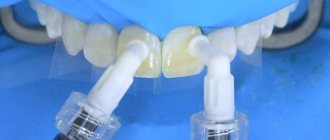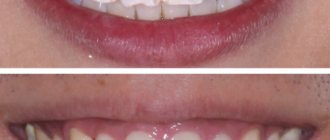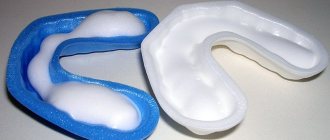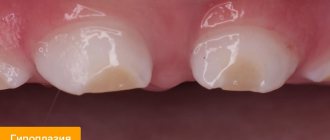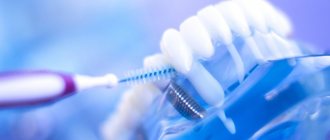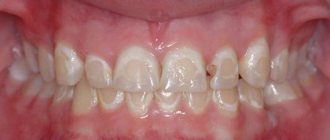Operating principle
Plaque that forms daily contains a huge amount of bacteria. By releasing acids of various compositions, bacteria destroy the enamel, as if dissolving the calcium molecules in it, and thereby deprive it of its protective properties. The compounds included in the RemarsGel complex have the ability to gradually penetrate the tooth enamel and replace lost calcium. “RemarsGel” actually “repairs” the area of tooth enamel that has lost its strength, strengthens it and helps restore the natural protection of the tooth.
During the process of brushing teeth with “RemarsGel”, calcium nitrate from tube No. 1 is mixed with ammonium hydrogen phosphate from tube No. 2. As a result of a safe chemical reaction, a brushite crystal is formed on the surface of the teeth, similar in composition to the main component of tooth enamel (hydroxyapatite crystal). Due to its small size, the brushite crystal penetrates deeply into tooth tissue, restores enamel damaged by caries, closes microcracks and quickly relieves tooth sensitivity (even after professional whitening). After a course of using RemarsGel, the enamel becomes smooth and shiny, and a feeling of smoothness of the surface of the teeth appears, as if after polishing.
Basic recommendations
Be sure to use RemarsGel 1-2 times a day. Both treatment and prevention must be strictly daily! "RemarsGel" can be used both at home and for treatment in a dental clinic.
The course of treatment of tooth enamel consists of 20-28 procedures. In case of visible damage to the teeth, “RemarsGel” should be used every day until the enamel is restored, and then – to consolidate the action of the complex 1-2 times a week.
For preventive effects, 10-14 procedures are sufficient. The prophylactic course of “RemarsGel” is recommended to be carried out 3 times a year.
Remineralization of teeth with calcium and phosphates –
Preparations in this group will help get rid of initial caries in the white spot stage, strengthen the low-mineralized enamel of children's teeth, and are also suitable for routine prevention of caries in adults.
But it is worth knowing that the anti-caries effectiveness of this group of remineralization drugs is many times inferior to the anti-caries effectiveness of fluorides. Probably the best source of calcium and phosphates for remineralization is the CPP-ACP complex (amorphous calcium phosphate bound to casein phosphopeptides). It is found in GC Tooth Mousse and GC MI Paste Plus dental gels. These drugs are also intended for self-administration by patients (at home). They are used in courses of 30 days, applications are optimally carried out 2 times a day - morning and evening immediately after meals and subsequent brushing of teeth. The minimum permissible frequency of applications is once a day, but you must understand that in this case the effectiveness will be somewhat lower (therefore, it is better to increase the duration of the course in this case).
Tooth gel “GC Tooth Mousse” –
manufacturer – GC (Japan/USA),- active ingredients – 10% amorphous calcium phosphate associated with casein phosphopeptides (CPP-ACP), as well as xylitol,
- abrasiveness – RDA 0,
- without fluoride, lauryl sulfate and parabens,
- tube 35 ml (40 g) – from 1200 rubles.
Comments: GC Tooth Mousse tooth gel is suitable for adults and children from 1 year of age. You can achieve the best result if you apply it 2 times a day (morning and evening) for a course of 30 days. The minimum acceptable option is to make applications only once a day, in the evening. Both in the morning and in the evening, applications are carried out every time after a meal and after brushing your teeth (i.e. you had breakfast, brushed your teeth and made an application). Same thing in the evening. The only contraindication to the use of this product is an allergy to milk proteins.
Unlike other remineralizing gels, GC Tooth Mousse is not afraid of saliva, and in addition, it needs it (therefore, there is absolutely no need to use this gel with mouth guards). For each row of teeth, a large pea-sized amount of gel is used, which is distributed over the teeth with the index finger. After applying the gel, try not to spit anything for 3 minutes, or even better, 5 minutes. After this, you can carefully spit out the saliva, but do not drink anything or rinse your mouth for another 30 minutes. If the course is carried out for adults, then we recommend that during the time (during which the remineralization course will last and some time after it) use slightly less abrasive pastes than recommended (with an RDA index of about 50).
→ Instructions for use of GC Tooth Mousse (PDF)
Tooth gel “GC MI Paste Plus” –
manufacturer – GC (Japan/USA),- active ingredients – 10% amorphous calcium phosphate bound to casein phosphopeptides (CPP-ACP), xylitol, sodium fluoride,
- fluoride content – 900 ppm,
- abrasiveness – RDA 0,
- without fluoride, lauryl sulfate and parabens,
- tube 35 ml (40 g) – from 1450 rubles.
Comments: GC MI Paste Plus dental gel differs from the previous product in that it additionally contains a small dosage of fluoride (900 ppm sodium fluoride). Scientific work has shown that the addition of fluoride increased the strength of the remineralizing effect of GC MI Paste Plus by approximately 15% (compared to GC Tooth Mousse gel). The gel can be used at home without restrictions - in adults and children from 12 years of age. But in children from 6 to 12 years old - according to the instructions, it should be used only in a dental office.
Scientific research shows that a course of use of the GC MI Paste Plus dental gel has a better effect in terms of remineralization of teeth and their protection from caries (if the result is assessed after 3 months) - in comparison with professional treatment of teeth with varnish with 5% sodium fluoride at the dentist and parallel use of fluoride toothpaste. The only contraindication to the use of this drug is an allergy to milk proteins, and you will see detailed instructions for use in the file attached below.
→ Instructions for use GC MI Paste Plus (PDF)
Gel ROCS medical minerals –
Another popular teeth remineralization gel that you can use on your own. The only advantage of this gel is its low price (from 300 to 360 rubles per 35 ml tube), but in terms of effectiveness it is significantly inferior to previous products. It should also be noted that in order to achieve any noticeable effect from its use, special mouthguards for teeth will be needed. You can read more about this gel in the article at the link below, and there you will also find information about the comparative effectiveness of the ROCS gel with other similar products.
→ Remineralization of teeth with ROCS minerals gel
Electrophoresis of calcium gluconate solution –
Almost every state dental clinic has a physiotherapy room. From your dentist you can receive a referral for electrophoresis of a 10% calcium gluconate solution, or 2.5% calcium glycerophosphate (a course of 10-15 procedures). But let’s say right away that buying and rubbing tablets with calcium gluconate into tooth enamel will be a completely useless exercise, because... dissociation of calcium gluconate with the release of active calcium ions is possible only through electrophoresis. But after a course of electrophoresis, it would be logical to carry out several dental fluoridation procedures.
Clinical study
RemarsGel is a product that has the unique ability to restore damaged or weakened tooth enamel that is ready for damage; it was originally called Remogel. Research on this drug took place at the Department of Pediatric Therapeutic Dentistry of the Moscow State Medical and Dental University. The purpose of the test was to determine the compliance of the Remogel gel with the possibility and feasibility of its use in dental institutions of the Russian Federation.
During the test, the simplicity and accessibility of the method of using the gel was revealed, and a pronounced remineralizing effect of the gel on foci of demineralization in caries was established. The study showed that Remogel successfully passed medical tests and can be recommended for widespread use in medical practice.
Dissertation of Doctor of Medical Sciences Volkov Evgeniy Alekseevich:
“Pathological changes in the hard tissues of teeth often begin with focal demineralization, leading to dental caries and its complications, as well as non-carious lesions, accompanied by dentin exposure and hyperesthesia. Therefore, mineralization of enamel and dentin, elimination of focal demineralization and hyperesthesia of teeth are a measure for the prevention of more severe pathological processes... A new generation of domestic dental materials and new methods of mineralizing therapy for the pathology of hard dental tissues with the material “BV” (for clinical use - approx. “Gekom”) and a set of gels “Remogel” (now “RemarsGel” - note by “Gekom”) were introduced into practical healthcare at the industry level (included in the State Register).”
Simple and deep fluoridation
Strengthening tooth enamel in children in dentistry using simple remineralization can be done in two ways:
- Using remineralizing gel. At night, the teeth are treated with Tooth Mousse or ROKS Medical Minerals.
- Coating teeth with fluoride varnish. At the beginning of the procedure, the doctor cleans the enamel from soft plaque, then applies varnish and dries it with a lamp. To achieve maximum effectiveness, the procedure is recommended to be carried out immediately after teething and repeated every 6 months.
Deep remineralization is aimed at comprehensive restoration and strengthening of enamel. It is carried out in several stages:
- removing bacterial plaque and hard deposits, cleaning the interdental space, drying the enamel;
- applying a composition that contains fluorides, copper and magnesium salts, drying the treated surfaces;
- surface treatment with calcium hydroxide.
Effective remineralization is achieved due to the fact that drug molecules penetrate deep into hard tissues. The drugs used have a long-lasting bactericidal effect, which makes it possible to suppress pathogenic microflora in the oral cavity.
Dentists recommend deep fluoridation to be carried out annually. The result of this procedure is a reduction in tooth hypersensitivity, an increase in enamel hardness up to 10 times, and a significant reduction in the risk of developing caries and other dental diseases.
